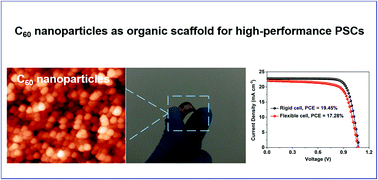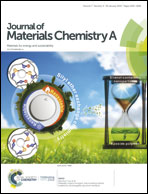Room-temperature-processed fullerene single-crystalline nanoparticles for high-performance flexible perovskite photovoltaics†
Abstract
Organic–inorganic hybrid perovskite solar cells (PSCs) employing a mesoporous metal-oxide scaffold are now at the forefront of solution-processed photovoltaic cells, yielding a power conversion efficiency exceeding 23%. However, processing temperatures of up to 450 °C are typically required to sinter mesoporous metal-oxide scaffolds, which hinders the fabrication of low-cost and flexible devices. Moreover, these metal-oxide scaffolds usually suffer from high charge carrier recombination rates and inherent UV instability. In this paper, we develop for the first time an organic-scaffold architecture, which consists of room-temperature-processed C60 single-crystalline nanoparticles (C60-NPs) serving as an electron selective contact covering on C60 compact films (c-C60). C60-NPs act as a three-dimensional framework to support perovskite crystals, enabling them to cover the substrate more uniformly and thus demonstrating an advantage over planar heterojunction PSCs. Furthermore, the higher electron mobility of C60-NPs compared with commonly used TiO2 enhances the charge transfer from the perovskite to electron transport layers and reduces charge carrier accumulation at the interface, demonstrating the advantage of an organic scaffold over inorganic metal-oxides for mesoporous scaffold PSCs. A power conversion efficiency (PCE) of 19.45% was obtained in organic-scaffold MAPbI3-based perovskite solar cells (OPSCs), outperforming standard reference devices based on a TiO2 mesoporous scaffold (maximum PCE = 17.07%). Furthermore, the high UV stability of C60-NPs enables the realisation of ultra-stable OPSCs stressed under ambient conditions and working under both UV and full-sun illumination. Moreover, the devices can be easily processed at low temperatures, providing an efficient method for the large-scale production of flexible PSCs. These flexible PSCs show remarkable performance with an excellent PCE of 17.28%, which is among the highest values reported for MAPbI3-based flexible PSCs to date. This work reveals that organic nanostructures as n-type charge collection layers are ideal replacements for inorganic mesoporous scaffolds as they achieve remarkably high efficiency and long-term operational stability in both rigid and flexible perovskite solar cells.

- This article is part of the themed collection: 2019 Journal of Materials Chemistry A HOT Papers


 Please wait while we load your content...
Please wait while we load your content...